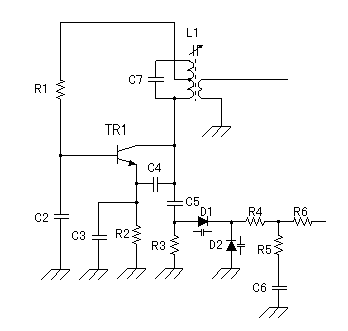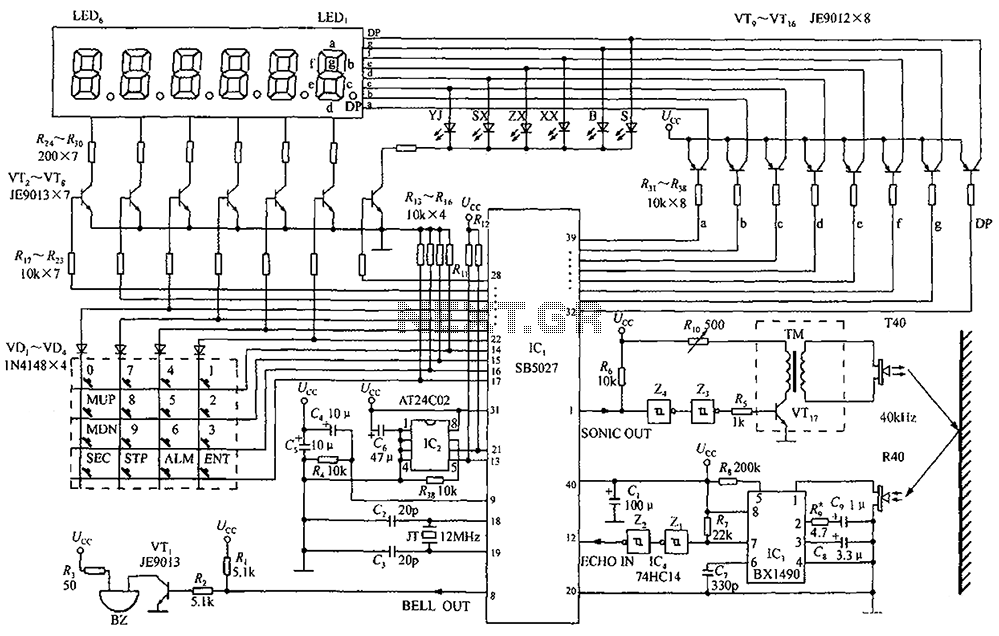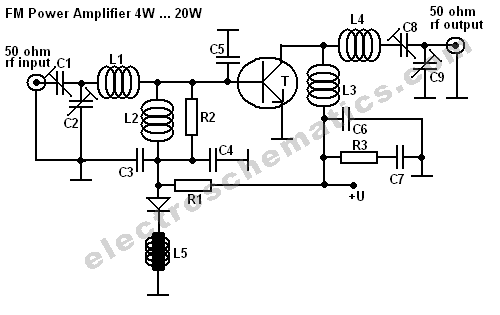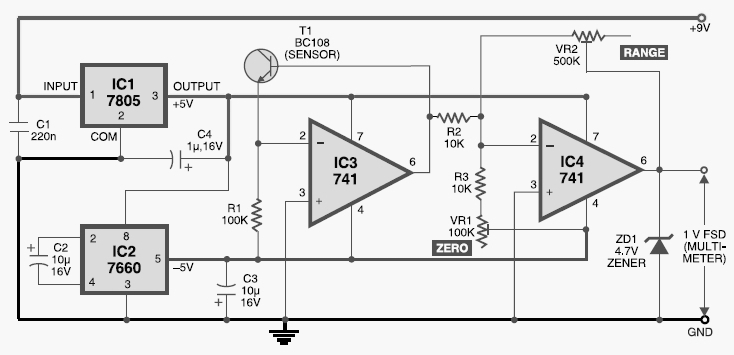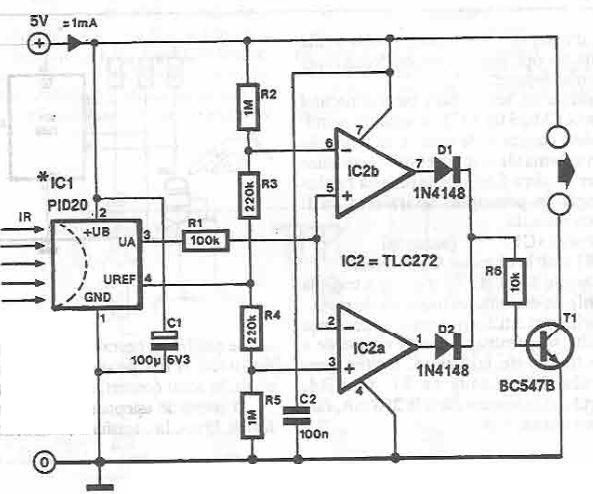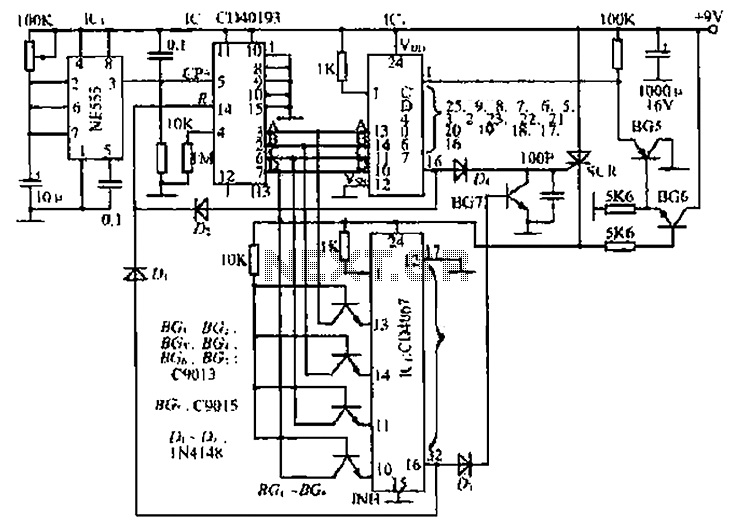
Ultrasonic parking sonar circuit design project
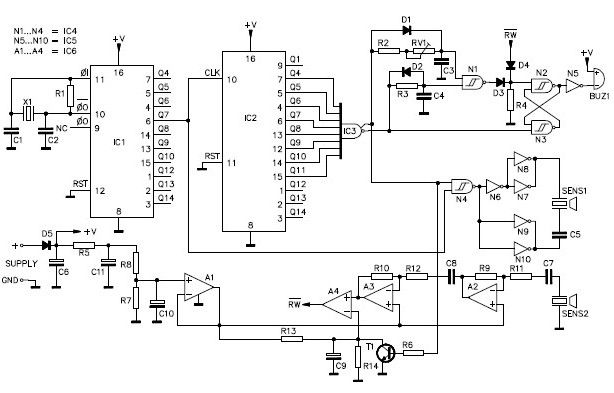
A simple ultrasonic parking sonar electronic project can be designed using this schematic circuit. This ultrasonic parking sonar project features an adjustable detection range from 5 cm to 1.5 meters and a detection angle of 5 degrees. The circuit operates at a transmitter frequency of 45 kHz and requires a DC power supply that can provide an output voltage between 10 and 15 volts at a current consumption of 16 mA. The circuit is activated when the gear is shifted into reverse, indicated by a beep tone, and will detect any obstacles within the sensor range. The detection distance sensitivity can be adjusted using the trimmer RV1, with a practical detection distance of approximately 25 to 30 cm from the rear of the vehicle. The components required for this circuit include: R1: 10 MΩ, R2: 22 kΩ, R3, R4: 27 kΩ, R5: 47 Ω, R6, R13: 10 kΩ, R7, R8, R9, R10: 15 kΩ, R11, R12: 1 kΩ, R14: 270 kΩ, D1, D2, D3, D4: 1N4148, D5: 1N4007, C1, C2: 12 pF, C3: 22 nF, C4, C7, C8: 10 nF, C5, C9: 100 nF, C6: 470 µF, C10: 10 µF, C11: 100 µF, RV1: 470 kΩ, IC1: CD4060, IC2: CD4020, IC3: CD4068, IC4: CD4093, IC5: CD4049, IC6: TL074, T1: BC547, SENS 1: MA40A5S, SENS 2: MA40A5R.
The ultrasonic parking sonar circuit operates by emitting ultrasonic waves through the transmitter sensor (SENS 1: MA40A5S). These waves travel until they encounter an obstacle, at which point they are reflected back to the receiver sensor (SENS 2: MA40A5R). The time taken for the waves to return is measured, allowing the circuit to calculate the distance to the obstacle based on the speed of sound in air.
The circuit is powered by a DC power supply, which must provide a stable voltage of 10 to 15 volts to ensure reliable operation. The current consumption of 16 mA indicates a low-power design, making it suitable for automotive applications without significant impact on the vehicle's electrical system.
The adjustable detection range allows users to set the sensitivity according to their needs, with RV1 (470 kΩ) serving as the trimmer potentiometer for fine-tuning. The beep tone activated during reverse gear engagement serves as an audible alert, enhancing driver awareness of potential obstacles.
The component selection includes various resistors, capacitors, diodes, and integrated circuits that work together to process the ultrasonic signals. The CD4060, CD4020, CD4068, CD4093, CD4049, and TL074 ICs form the core logic and processing units, enabling the circuit to function effectively. The use of a transistor (T1: BC547) allows for signal amplification, ensuring that the detected signals are strong enough for processing.
Overall, this ultrasonic parking sonar circuit design offers a practical and efficient solution for enhancing vehicle safety during parking maneuvers, with a focus on simplicity and effectiveness in obstacle detection.A very simple ultrasonic parking sonar electronic project can be designed using this schematic circuit. This ultrasonic parking sonar electronic project has an adjustable detection range from 5 cm up to 1.
5 meters and a detection angle of 5 degrees. This ultrasonic parking circuit has a transmitter frequency of 45kHz and require a dc power suppl y circuit that can provide a output voltage between 10 and 15 volts at 16 mA output current (consumption current). The circuit is activated as soon as the gear is shifted in reverse (this is marked by a `bip` tone) and will detect any obstacle within the range of the sensors, the detection distance ( sensitivity) being adjusted by means of the trimmer RV1.
A distance of approx. 25 to 30cm from the backside of the car seems to be a value of practical use. Components required by this circuit are : R1 : 10M, R2 : 22K, R3, R4: 27K, R5 : 47, R6, R13 : 10K, R7, R8, R9, R10 : 15K, R11, R12 : 1K, R14:270K, D1, D2, D3, D4: 1N4148, D5 : 1N4007, C1, C2: 12pF, C3 : 22nF, C4, C7, C8: 10nF, C5, C9: 100nF, C6 : 470 µF, C10 : 10 µF, C11 : 100 µF, RV1 : 470K, IC1 : CD4060, IC2 : CD4020, IC3 : CD4068, IC4 : CD4093, IC5 : CD4049, IC6 : TL074, T1: BC547, SENS 1 :MA40A5S, SENS 2 :MA40A5R. 🔗 External reference
The ultrasonic parking sonar circuit operates by emitting ultrasonic waves through the transmitter sensor (SENS 1: MA40A5S). These waves travel until they encounter an obstacle, at which point they are reflected back to the receiver sensor (SENS 2: MA40A5R). The time taken for the waves to return is measured, allowing the circuit to calculate the distance to the obstacle based on the speed of sound in air.
The circuit is powered by a DC power supply, which must provide a stable voltage of 10 to 15 volts to ensure reliable operation. The current consumption of 16 mA indicates a low-power design, making it suitable for automotive applications without significant impact on the vehicle's electrical system.
The adjustable detection range allows users to set the sensitivity according to their needs, with RV1 (470 kΩ) serving as the trimmer potentiometer for fine-tuning. The beep tone activated during reverse gear engagement serves as an audible alert, enhancing driver awareness of potential obstacles.
The component selection includes various resistors, capacitors, diodes, and integrated circuits that work together to process the ultrasonic signals. The CD4060, CD4020, CD4068, CD4093, CD4049, and TL074 ICs form the core logic and processing units, enabling the circuit to function effectively. The use of a transistor (T1: BC547) allows for signal amplification, ensuring that the detected signals are strong enough for processing.
Overall, this ultrasonic parking sonar circuit design offers a practical and efficient solution for enhancing vehicle safety during parking maneuvers, with a focus on simplicity and effectiveness in obstacle detection.A very simple ultrasonic parking sonar electronic project can be designed using this schematic circuit. This ultrasonic parking sonar electronic project has an adjustable detection range from 5 cm up to 1.
5 meters and a detection angle of 5 degrees. This ultrasonic parking circuit has a transmitter frequency of 45kHz and require a dc power suppl y circuit that can provide a output voltage between 10 and 15 volts at 16 mA output current (consumption current). The circuit is activated as soon as the gear is shifted in reverse (this is marked by a `bip` tone) and will detect any obstacle within the range of the sensors, the detection distance ( sensitivity) being adjusted by means of the trimmer RV1.
A distance of approx. 25 to 30cm from the backside of the car seems to be a value of practical use. Components required by this circuit are : R1 : 10M, R2 : 22K, R3, R4: 27K, R5 : 47, R6, R13 : 10K, R7, R8, R9, R10 : 15K, R11, R12 : 1K, R14:270K, D1, D2, D3, D4: 1N4148, D5 : 1N4007, C1, C2: 12pF, C3 : 22nF, C4, C7, C8: 10nF, C5, C9: 100nF, C6 : 470 µF, C10 : 10 µF, C11 : 100 µF, RV1 : 470K, IC1 : CD4060, IC2 : CD4020, IC3 : CD4068, IC4 : CD4093, IC5 : CD4049, IC6 : TL074, T1: BC547, SENS 1 :MA40A5S, SENS 2 :MA40A5R. 🔗 External reference
